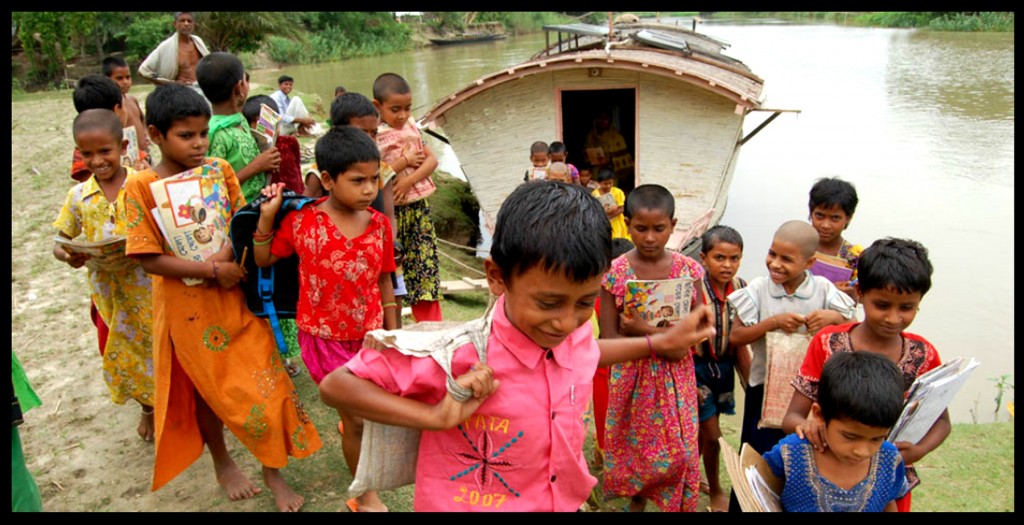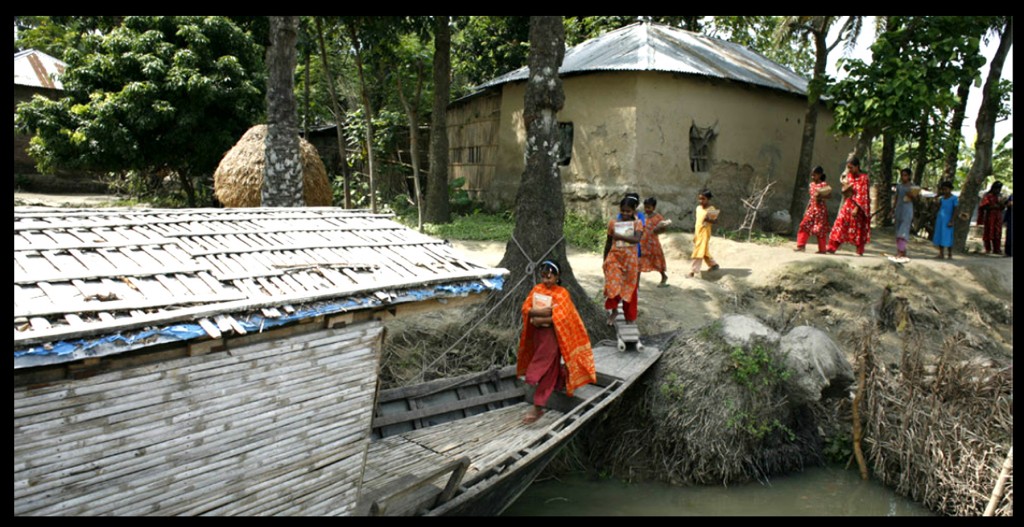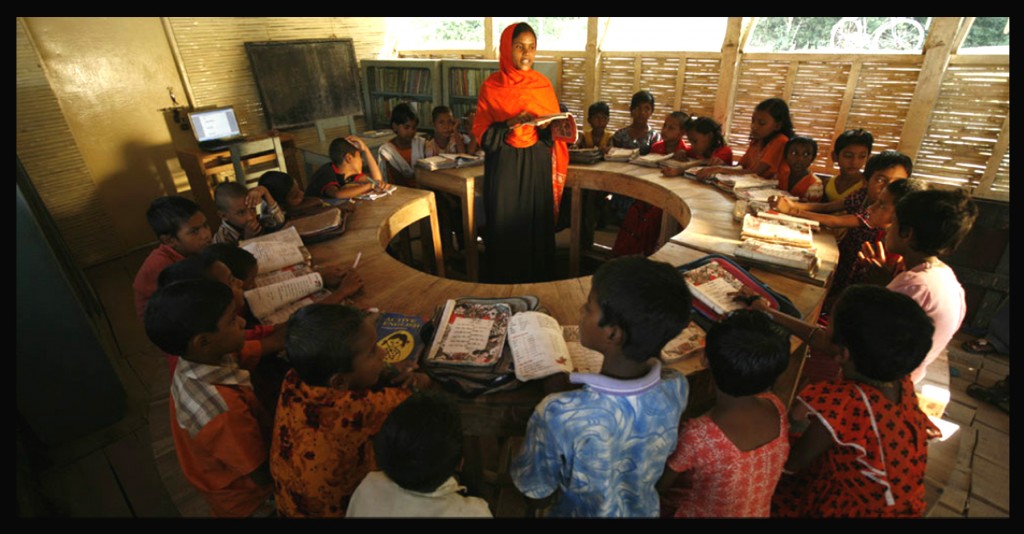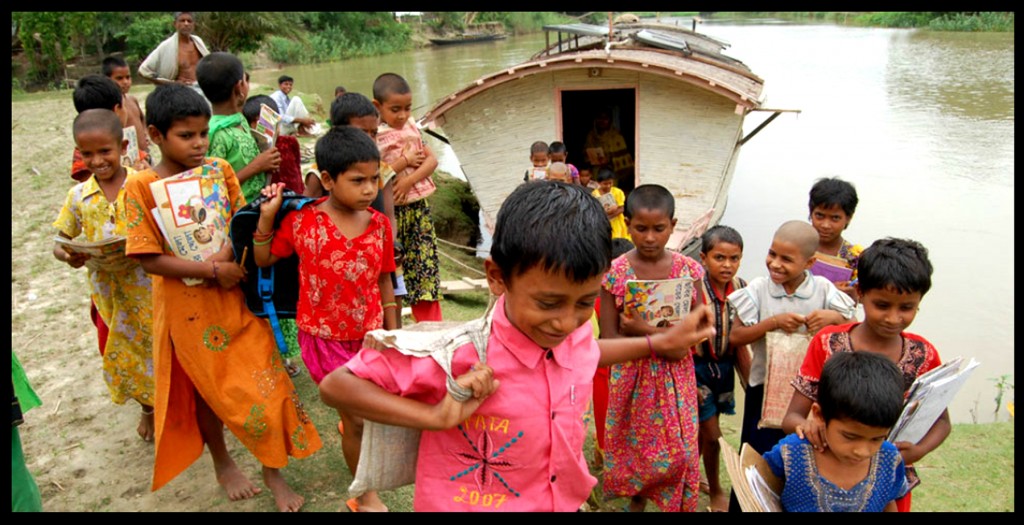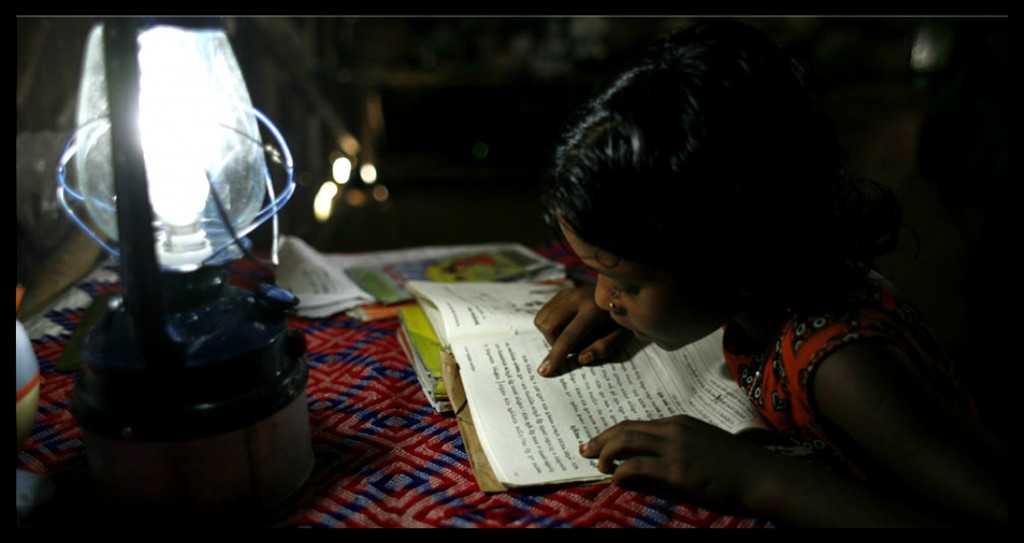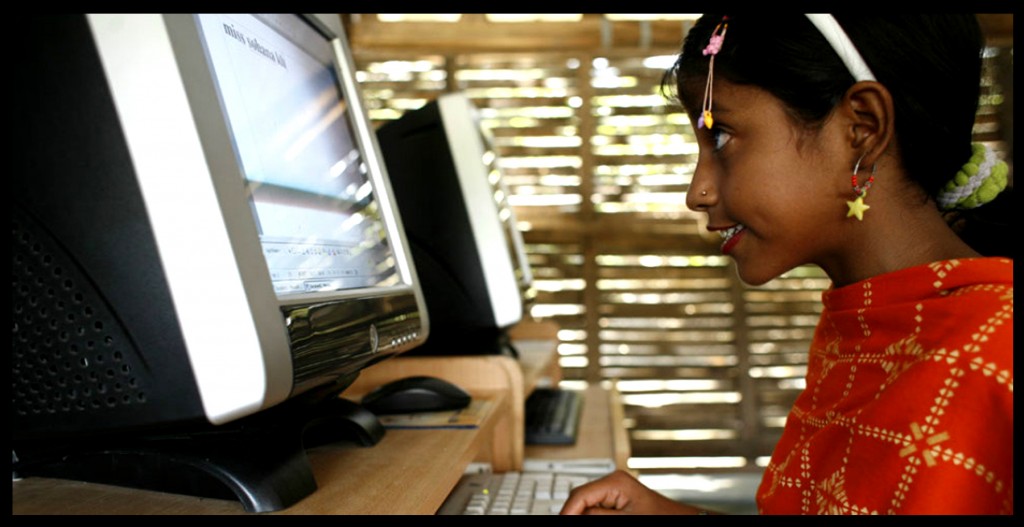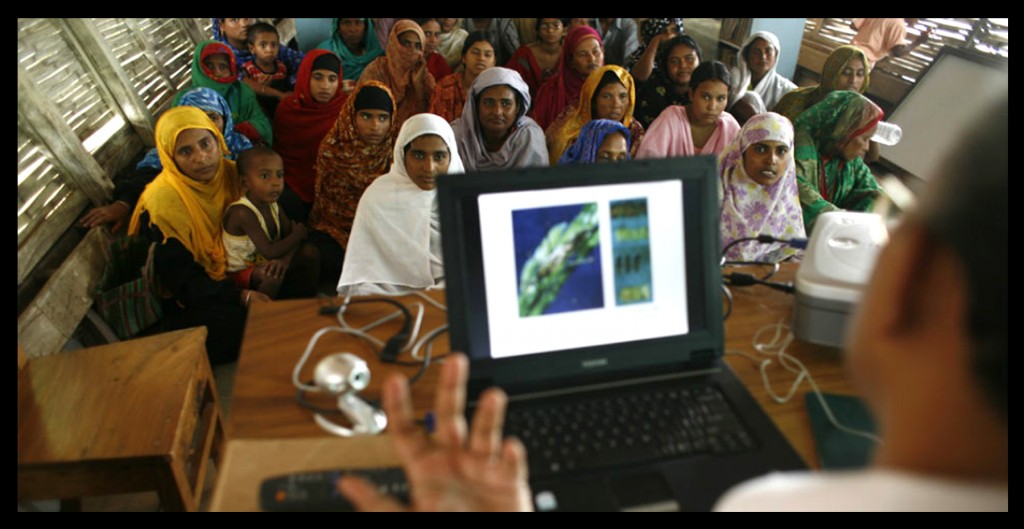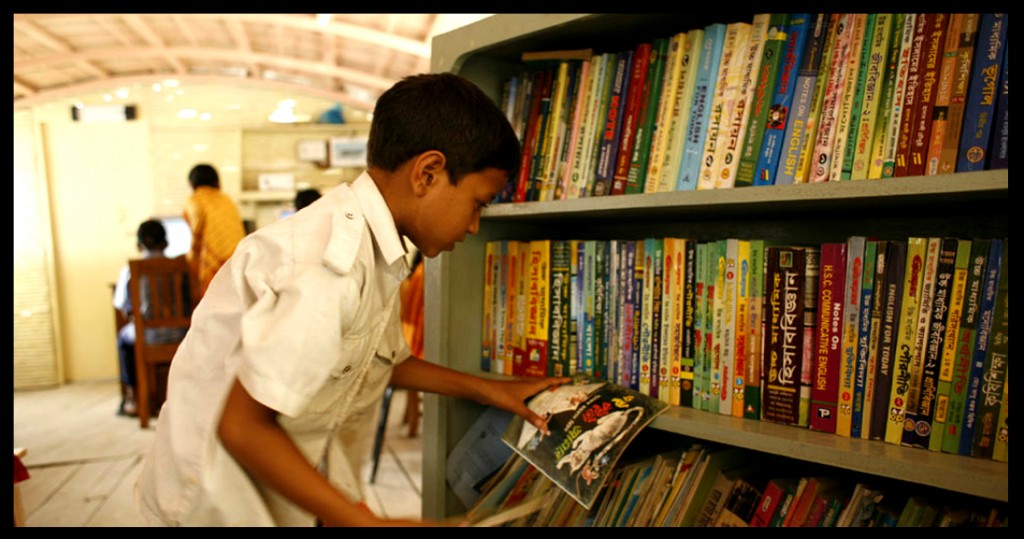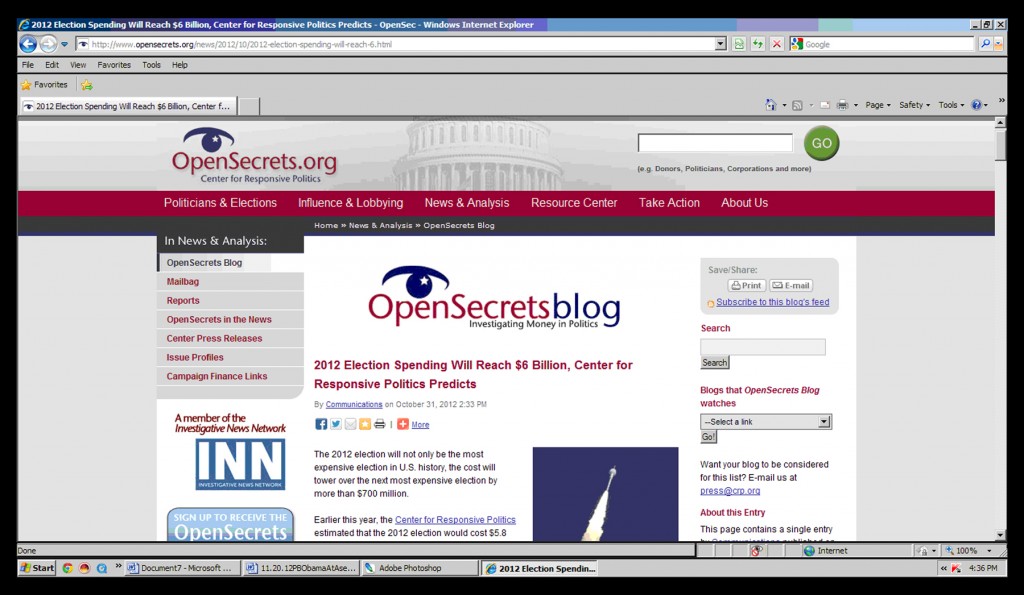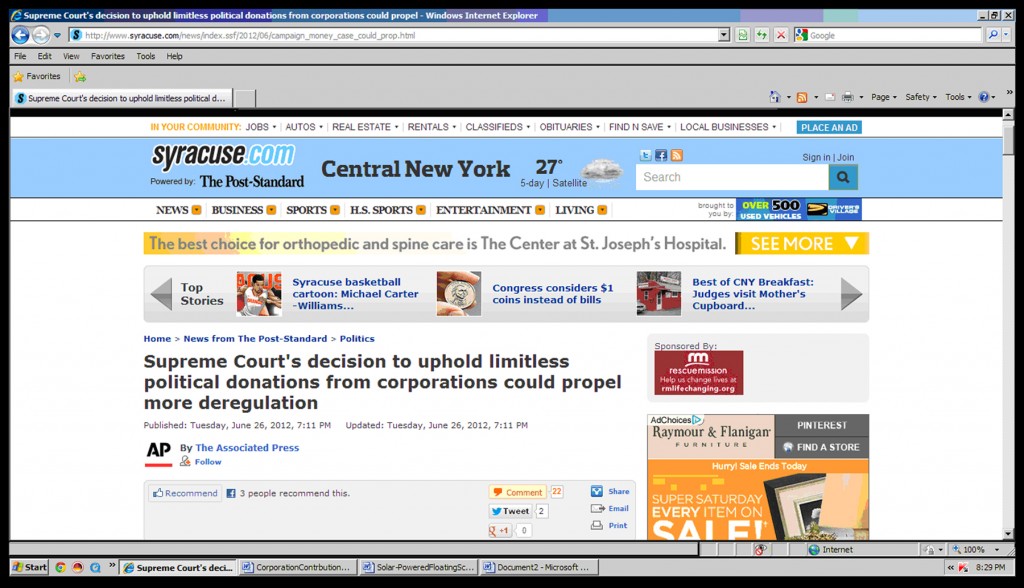The Solar-Powered Floating Schools in Bangladesh
Little Bare Feet Go To School
Tip toe, tip toe
Our little bare feet are marching to school
Faces smiling with happiness
We are going to school
“Where is your older sister?”
Is she coming to school too?”
“Oh, she has to stay home taking care of our baby sister.
But I will bring some story books for her.
She will come next week and I will stay home taking care of our sister.”
“Did you read Cinderella?
She lost her shoe.”
“I wish I had her Godmother
Then she can give me a pair of nice shoes.”
“Watch out!
Don’t step on that sharp rock; it will hurt your foot.”
“I can jump over it.
Come on, let’s jump over the rocks.
Oh it’s fun, fun, fun!”
“I wish I can come to school everyday
I love to learn and read books.”
“I love our teacher.
She is so nice.”
“Let’s go, I don’t want to be late”
Tip toe, tip toe
Ing-On Vibulbhan-Watts, Tuesday, November 27, 2012, 12:02 A.M.

Link: https://www.bbc.co.uk/news/in-pictures-20340184
A project that provides solar-powered floating schools in Bangladesh has been nominated for an award at the world Innovation Summit in Education in Doha,Qatar. This year’s shortlisted projects not only “transform education”, but also provide innovative financing of primary education.
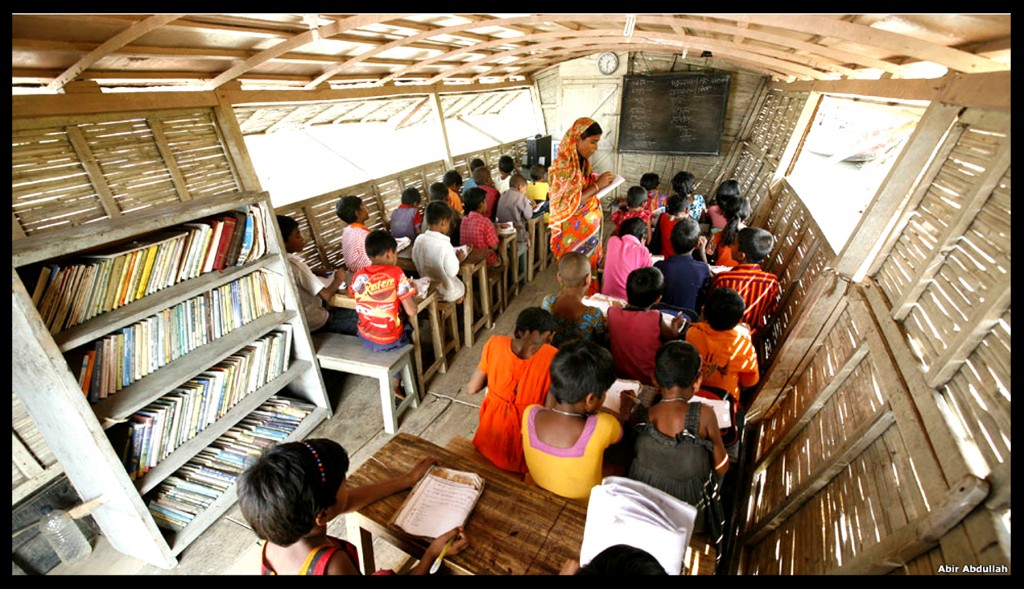
The project, initiated by the non-profit organization Shidhulai Swanirvar Sangstha, aims to provide facilities for uninterrupted education in Bangladesh especially during the height of monsoon season.
The boats collect children from various villages along the riverside, each having space for a classroom of 30 students. There are 20 boats in operation, reaching more than 1,600 students.
With a background in architecture and construction, Rezwan took on the challenge. “It is common to see school dropouts in this region. It was difficult for me to accept the situation. I thought that if the children cannot come to the school for lack of proper transportation, then the school should come to them by boat.”
At the moment finance for the project comes from local and international contributions but the organization is exploring alternative business models for future funds. All photos courtesy: Shidhulai Swanirvar Sangstha.
Low-cost solar lanterns are also provided so that students can continue their studies at home.
Mohammed Rezwan, executive director of Shidhulai Swanirvar, is a native of Natore district. “I saw first-hand the hardship of riverside communities who have no access to information and the opportunities it affords. With roads impassable during the monsoon, students cannot make the trek to the school.”
The schools provide primary education but also run training courses for adults in subjects such as sustainable farming, women’s rights, marketing, nutrition and adaptation to climate change.
As well as internet-linked laptops and PCs, the schools also house a well-stocked library.
Pressure on land is high with much of the population crammed into a delta of rivers that empties into the Bay of Bengal. The low-lying country is vulnerable to flooding which limits movement.
Ing’s Comments:
I usually visit BBC news, reading the news. I enjoy seeing the, In Pictures, section. I was so glad to see the pictures of the, Solar-Powered Floating Schools. As I examined one of the pictures showing a group of children walking to the Solar-Powered Floating School, I noticed that none of the children had shoes. They were all walking bare foot. I felt so sad. When I showed the picture to John I said, “Children here (USA) have so many pairs of shoes, some with fancy designs with light and other luxury shoes. But some of the children here are still not satisfied and are unhappy with their lifestyle. Kids here should see the children in this picture that have no normal school and even have no shoes. I hope they have enough food to survive.” John’s commented that, “But kids in the picture are smiling, they probably are happier than some of the kids here.”
I am glad that there are some organizations helping these kids to educate. I am grateful and appreciated for their kindness and concern for the unfortunate and poor children. I always wonder about governments that are supposed to help their people, especially providing schools for their own citizen. Generally I hear about corrupt politicians fighting among themselves and taking money to Swiss or other off shore banks. They give wealth to their families and friends but leave none or very little to develop their countries, which is their duty as government officials.
Most of children, no matter where they are if they were born with normal brains are capable of learning if we provide the facilities and knowledge for them. Unfortunately in present society there are two end groups of people. One group, which is a small percent, is very rich and the other, which is the majority of world population, is very poor. It is just tough luck for the poor left only with rotten garbage to keep them alive. At the same time it is so sad to realize that the total expense for US Presidential and congressional elections cost almost six billion dollars.
“2012 Election Spending will reach $6 Billion, Center for Responsive Politics Predicts by Communications on October 31, 2012 2:33 PM. The 2012 election wills not only be the most expensive election in U.S.history, the cost will tower over the next most expensive election by more than $700 million. Earlier this year, the Center for Responsive Politics estimated that the 2012 election would cost $5.8 billion — an estimate that already made it the most expensive in history — but with less than a week to go before the election, CRP is revising the estimate upwards. According to CRP’s new analysis of Federal Election Commission data, this election will likely cost $6 billion.”
Please read more information at the end of this article or visit the website that I have provided and click on the links to more information.
The comparison between the expenses to provide poor children with an education and the US election costs make me confused and sad. How can we be so a different, unequal and uncivilized? The ones who can obtain or gain will do as much as they can for themselves and left nothing for others. The US government spends so much money to fight terrorists. Would it not be better to help educate poor children to have better chance in their lives and society? Or should we leave poor children in the mercy of extremists who brainwash them and use them as weapons to destroy the US and other countries? I do not imply that all poor children will get brainwashed and become terrorists. But some who are unfortunately joining the extremists for necessity of survival, just to have food to eat and a place to sleep or get sold by poor parents.
But when I saw the pictures from BBC News, In Pictures about Solar-Powered floating Schools, this encouraged me and have hope. It gives me have hope for humanity. Hope that there will be more generous group of people providing these Floating Schools and other types of schools to help very poor children. It gives me hope for technology to be utilized in progressive ways to help the underdeveloped poverty areas. Solar energy can be used to develop countries through research, helping improve this industry and the countries involved. Solar energy gives us energy without creating pollution. These Solar-Powered Floating School children can utilize and familiarize themselves with the technology that provides the power for them. When they grow up they will follow this good example. I hope that some of them will be scientists and be able to discover other technology that might advance science far beyond what we have at the present time.
It takes so little money to cultivate and educate poor children compared to the spending of the US elections, wars, and wasteful ways used to fight of terrorists. We can change this if we really sincerely want to do so.
Ing-On Vibulbhan-Watts, Friday, November 30, 2012, 11:15 PM
https://www.opensecrets.org/news/2012/10/2012-election-spending-will-reach-6.html
2012 Election Spending Will Reach $6 Billion, Center for Responsive Politics Predicts
By Communications on October 31, 2012 2:33 PM
The 2012 election will not only be the most expensive election inU.S.history, the cost will tower over the next most expensive election by more than $700 million.
Earlier this year, the Center for Responsive Politics estimated that the 2012 election would cost $5.8 billion — an estimate that already made it the most expensive in history — but with less than a week to go before the election, CRP is revising the estimate upwards. According to CRP’s new analysis of Federal Election Commission data, this election will likely cost $6 billion.
The most significant difference compared with earlier cycles is the unprecedented money being raised and spent by outside – and ostensibly independent – organizations, which we are predicting will spend more than $970 million.
“In the new campaign finance landscape post-Citizens United, we’re seeing historic spending levels spurred by outside groups dominated by a small number of individuals and organizations making exceptional contributions,” said Sheila Krumholz, executive director of the Center for Responsive Politics.
Not only is the total cost of the election record breaking, but the rate at which spending has increased — and continues to increase — in the closing weeks of the election is as well. In particular, outside groups are spending furiously. Spending by these groups, for and against the two main presidential candidates, has grown from $19 million per week in early September to $33 million per week in early October to $70 million during the week beginning October 21.
The presidential election alone accounts for $2.6 billion, which is actually a decrease from 2008 when, all told, nearly $2.8 billion was directed at the presidential race. In 2012, presidential candidates along with major party committees are expected to spend about $2 billion. Outside organizations that report spending to the Federal Election Commission are predicted to spend more than $528 million to influence the presidential race. Spending by the party convention host committees and public funding for the conventions totaled $142 million.
Spending in congressional races is projected to increase slightly in 2012. House and Senate candidates combined will spend about $1.82 billion, up from $1.81 in 2010. House campaign spending alone will total nearly $1.1 billion, a slight increase of 3 percent more over 2010. In the Senate, spending by candidates will approach $743 million, which is down about 7 percent compared to 2010.
The increase in the House is mainly among Republican candidates and is accounted for by the big increase in Republican House members due to the 2010 wave election. Incumbents outraise their challengers, in general, and freshmen often raise more than other incumbents because their first reelection campaign is seen as their most difficult. This year is proving no different.
Congressional races are being affected by the huge increase in outside spending as well. For just the week beginning October 20, outside spending in the 59 House contests rated either toss up or leaning to one party or the other by Real Clear Politics totaled $41 million
Together, all candidates for Congress have raised more than $1.7 billion, based on data available from the FEC as of October 30, 2012. Incumbents have a sizable advantage, the Center found, with the average incumbent senator raising $11 million over his or her six-year term, compared to $1.2 million for the average challenger, an advantage of nearly 10-to-1. Candidates in open seats raised more than $2.5 million on average. In the House, the average incumbent raised $1.5 million compared to just $245,000 for average challenger. Candidates vying for open seats in the House raised, on average, more than $453,000. Self-funding candidates have spent more than $200 million of their own money to run for office in 2012.
Republican candidates have raised more than their Democratic counterparts in both chambers this election cycle. Republican House candidates have also raised more on average — $712,000 to $594,000, –though Democrats did better than Republicans in the Senate, on average, raising $3.8 million to Republicans’ $2.6 million on average. Overall it appears Republicans will end up collecting $1.1 billion, or 55 percent of the money raised by congressional candidates in 2012. In 2010 overall, Republicans outraised their Democratic counterparts by 15%.
Despite heavy losses by incumbents in the 2010 “wave election,” 2012 is likely to see reelection rates climb back to their usual high levels. Since 1992, House election rates never dipped below 94 percent until they fell to 85 percent in 2010. In the Senate, where reelection rates are more variable, incumbents have nevertheless won in at least 79 percent of their races over the past two decades. Incumbents won reelection 84 percent of the time in 2010.
The potential for huge outside amounts, sometimes realized, sometimes not, has likely helped drive all committees and outside groups involved in these elections to redouble their efforts to collect more money. Outside organizations are predicted to spend $187 million in House races and $258 million in Senate races.
Of the $970 million to be spent by outside groups, super PACs (which make only “independent expenditures” and report both their donors and spending to the Federal Election Commission) have, so far, spent $540 million and politically active nonprofits and others have spent $351 million.
HUNDREDS OF MILLIONS OFF THE BOOKS
What remains unknown — and may never fully be accounted for — is how much money secretive “shadow money” organizations spent, with some investing massive sums on ads, but also on unreported and purportedly “non-political” activities, as the election neared. It may take years to determine how much they spent. Furthermore, it likely will never be known who provided the vast majority of this money, which includes at least $203 million in the last two months.
“One thing we can say for certain is that the transparency the Supreme Court relied upon to justify this new framework has been sorely lacking,” said Krumholz.
In addition to the spending reported by nonprofits, however, at least $100-200 million more has been spent by these groups on “issue advocacy” that identifies a federal candidate, but was not required to be reported to the FEC. This is of concern because a number of these organizations — particularly those that have organized since the Citizens United ruling, are spending huge sums and have super PAC counterparts — are primarily political in nature. More disturbing than the secret spending (some of which can be pieced together based on studies of political ads and will eventually be summarized in tax reports to the Internal Revenue Service), is the secret source of this money. With no requirements to disclose where the money is coming from, voters in 2012 have been left with no real means to judge the credibility of the message or consider any hidden agendas leading those donors to give.
The largest of these groups include American Crossroads and its nonprofit “social welfare” counterpart, Crossroads GPS, organizations conceived of by GOP strategist Karl Rove which together have reported spending more than $158 million on independent expenditures and electioneering communications. Restore Our Future, the super PAC supporting Mitt Romney’s presidential campaign has spent nearly as much, $125 million, on independent expenditures. Next on the list, but spending less than half as much, is Priorities USA Action, the super PAC supporting President Barack Obama. The US Chamber of Commerce, a 501(c)6 nonprofit and one of the most powerful interest groups in U.S. politics, reported spending $35 million on electoral activity, but routinely spends tens of millions more on unreported “issue advocacy” that target federal candidates. The fifth top spender is another 501(c)4 “social welfare” organization, Americans for Prosperity, which has spent about $34 million on political ads, but perhaps more importantly built a massive ground operation to get out the conservative vote.
SAME SOURCES, NEW STRATEGIES
Different candidates and different political committees used a variety of tactics.
President Obama’s campaign kept much of its fundraising in-house, churning to collect millions of small donations at least $214.3 million. The campaign also heavily tapped networks of wealthy and powerful supporters, known as bundlers, who combined to raise at least $180.1 million.
The Romney campaign never reached historic levels of fundraising but was aligned with powerful outside spending groups. While the campaign raised just $389 million (only a relatively small fraction, $70.8 million, raised from small donors), Romney’s campaign was undoubtedly buoyed by the support of Restore Our Future, which raised $131.6 million. It has spent one out of every five super PAC dollars this cycle.
“In reaction, candidates feel pressure to raise more funds,” said Bob Biersack, senior fellow at the Center for Responsive Politics. “Everybody reacts to this new environment by getting as much money as they can.”
The sources for money fueling the presidential campaign in 2012 reflect the same basic interests that fed the coffers of candidates in the 2008 presidential campaign. In 2008, among business, labor and ideological interests, the top 3 sectors providing funds to all presidential candidates were: Finance, Insurance and Real Estate, delivering $141.2 million (54 percent to Democrats); Lawyers and Lobbyists, with $100.7 million (78.2 percent to Democrats); and Miscellaneous Business interests, giving $86.6 million (63.6 percent to Democrats). Business interests account for about 62 percent of all contributions to all presidential candidates, with ideological, labor and other interests making up the rest.
In 2012, these same top sectors lead the list, with some important differences. FIRE delivered only $80.7 million to a smaller field of Republican candidates and only a single Democratic contender. More important, though, was how that money was distributed. This time, 76 percent of that went to all Republican candidates and 65 percent went to Romney alone. To date, Romney holds an advantage over Obama among financial interests by a margin of 5-to-2. Instead of Lawyers and Lobbyists, Miscellaneous Business is second contributing $52.2 million (60.2 percent to Republicans); and Lawyers and Lobbyists places third with $42.4 million (61.7 percent to Democrats).
Once again, within the financial sector, the primary powerhouse is Wall Street, which delivered $28 million to date this cycle. But, after heartily backing Obama four years ago, securities and investment firms pivoted sharply and threw their financial support behind Romney in 2012, sending him the lion’s share — $19.6 million — more than 3 times the amount contributed to Obama.
Lawyers and Law Firms supplied similar support in 2012, sending $40.2 million total to presidential candidates, but unlike Wall Street, Lawyers stuck with their favored candidate of 2008, sending Obama $25.7 million through October 17. While far less than the $46.5 million lavished on the Obama campaign in 2008, Obama’s 2012 haul from lawyers is still more than twice as much as Romney has so far received. The only other industry or interest group to deliver $20 million or more to the Obama campaign is Education. Education-related interests provided Obama with $20.1 million out of $24.3 million to all presidential candidates this cycle.
As in past cycles, when including all itemized donations, (beyond Business, Labor and Ideological interests), topping the Center’s 2012 list of big donors to all presidential candidates are contributors who list their occupation as “retired,” giving $121.3 million, divided nearly evenly between Obama and Romney: $54.5 million to Obama and $56.4 to Romney, with the rest distributed among other presidential candidates.
These major categories of top campaign support are reflected in the list of top organizations supporting the Obama and Romney campaigns. Employees of theUniversityofCaliforniahave contributed more than $1 million to the Obama campaign and 5 other universities are also among his top 20 organizational donors, along with 4 leading tech companies and government employees. Most of Romney’s top donors, on the other hand, are financial interests (16 of 20), the top 5 of which are all heavy hitters on Wall Street.
RISE OF THE WEALTHY DONOR
One important difference in fundraising for the two presidential campaigns has been the emphasis on small donors by the Obama campaign. Every presidential campaign focuses on maximum contributions from individuals, now commonly raised through joint-fundraising organizations receiving up to $75,800 from each individual, often delivered by bundlers seeking to demonstrate the extent of their support for a particular candidate. Less common is the ability of the Obama campaign to raise about 30% of his contributions in amounts less than $200 per person – more than $214 million through October 17 and three times the amount raised by Romney in similar amounts.
While small donors have played a role in this campaign, it remains extraordinarily unusual for Americans to contribute to political candidates, and the rise of unlimited contributions for outside spending has further concentrated financial participation in politics this year. For example, fewer than 40 donors to outside groups have given more than $200 million to those groups – while at least 350,000 people were needed to reach the $71 million in small donations to the Romney campaign. It’s also important to note that President Obama raised nearly twice as much money from donors giving more than $200 as he did from those giving $200 or less and Gov. Romney raised nearly 4.5 times as much from large individual donors than he did from small donors.
Women donors have also played an increasingly important role in presidential campaigns in recent cycles, and this cycle is no different. Continuing a rising trend over recent years, women donors have given 36% of the overall itemized individual money to the major party nominees, with the Obama campaign approaching gender parity, raising 44.2 percent of its itemized contributions from women, whereas Romney raised 28.5 percent from women giving more than $200.
Our estimates are based on comparisons between activity through September 30 and total cycle activity for past campaigns. These multipliers from the 2008 Presidential cycle have been employed to estimate this cycle’s totals based on activity through September 2012.
ABOUT THE CENTER FOR RESPONSIVE POLITICS
Celebrating its 30th year in 2013, the Center for Responsive Politics is the nation’s premier research group tracking money inU.S.politics and its effect on elections and public policy. The nonpartisan, nonprofit Center aims to create a more educated voter, an involved citizenry and a more responsive government. CRP’s award-winning website, OpenSecrets.org, is the most comprehensive resource for campaign contributions, lobbying data and analysis available anywhere. For other organizations and news media, CRP’s exclusive data powers their online features tracking money in politics. CRP relies on support from a combination of foundation grants and individual contributions. The Center accepts no contributions from businesses, labor unions or trade associations.
For more info call 202-354-0111 or email press@crp.org.
Categories:Outside Money,Politicians & Elections,Presidential Election,Press Releases
Tags:501(c)4,american crossroads,americans for prosperity,barack obama,bob biersack,bundlers,center for responsive politics,citizens united,CrossRoads GPS,education,finance insurance real estate,labor,lawyers,lawyers & lobbyists,miscellaneous business,mitt romney,nonprofits,priorities USA action,restore our future,securities and investment industry,shadow money,sheila krumholz,super pacs,u.s. chamber of commerce
Here are more links on campaign finance:
https://en.wikipedia.org/wiki/Campaign_finance_in_the_United_States
https://elections.nytimes.com/2012/campaign-finance/independent-expenditures/totals
Please read more on Supreme Court’s decision to uphold limitless political donations from corporations below and the links to the site as the following:
https://en.wikipedia.org/wiki/Citizens_United_v._Federal_Election_Commission#mw-head#mw-head
https://www.syracuse.com/news/index.ssf/2012/06/campaign_money_case_could_prop.html
WASHINGTON (AP) — If you thought the money race in the presidential campaign was already the Wild West, you haven’t seen anything yet.
The Supreme Court’s decision to uphold limitless political donations from corporations sets the stage for campaigns and outside groups to press boundaries even further. Hundreds of millions of dollars in outside spending will continue to pour into the presidential election as super political committees, or super PACs, are emboldened by the court’s ruling and feckless federal regulators.
Super PACs are increasingly blurring the lines between their ability to spend freely on political campaigns and the legal prohibition against coordinating directly with politicians. There are renewed calls for new federal rules that would permit unlimited contributions directly to candidates or anonymous large donations.
And the U.S. watchdog agency responsible for enforcing the rules — the Federal Election Commission — has been ineffectual. The FEC’s six members — three Democrats and three Republicans — have been deadlocked, unable to decide just how far super PACs can coordinate with campaigns.
Monday’s court ruling, part of a challenge to aMontanalaw banning corporate contributions, ends for now a controversial saga in the court’s 2010 Citizens United case. That case and other federal rulings have stripped away restrictions on political contributions from corporations, labor unions and millionaires and billionaires.
The case is already making its mark: Super PACs and their nonprofit arms have brought in more than $200 million in combined donations this election, with most of that going to GOP groups. The new rules have allowed major players like casino mogul Sheldon Adelson to contribute more than $20 million to support Republican candidates.
President Barack Obama’s campaign said Tuesday it is feeling the pressure of outside groups, pointing out that Obama would be the first incumbent president to be outspent by Republican Mitt Romney and super PACs working in Romney’s favor. Obama, of course, has his own super PAC working toward his re-election.
“From now until November, the other side will spend more money than at any time in American history,” the president said Monday in Durham, N.H. “And almost all of it will be on ads that tell you, ‘The economy is bad, it’s all Obama’s fault.’” The next day, Obama — who himself broke money records by bringing in $750 million four years ago — emailed supporters a fundraising plea with the subject line, “I will be outspent.”
The court reaffirmed that political speech is protected under the First Amendment even when its source is a corporation. And in an election already brimming with cash from super PACs, the decision leaves no ambiguity that the practice will continue. In effect, the decision left Citizens United standing and “the enormous damage it is doing to our democracy and political system,” said Democracy 21 President Fred Wertheimer, a frequent critic of super PACs and limitless money in politics.
Lines are blurring between the activities of super PACs and the campaigns that they are supporting. Obama has agreed to allow some senior political staff and even Cabinet members to attend fundraisers organized by Priorities USA Action, the super PAC supporting his re-election. When Romney hosted a lavishUtahretreat this weekend for his top campaign donors, officials from Republican super PACs — including Karl Rove of American Crossroads — spoke on panels or met with Romney’s campaign staff.
Those activities don’t violate election laws, which prohibit coordination of advertising between PACs and the campaigns they support. The two camps can talk with each other, and the candidates can appear at super PAC events. But the court’s ruling will embolden groups to strip away those esoteric distinctions.
Practically speaking, super PACs and candidates have long coordinated during this election. Super PACs working in a candidate’s favor employ their former advisers familiar with strategy. Some also use the same media and marketing companies.
The court’s decision was a victory for those who support few restrictions, saying the First Amendment affords them the right to spend as much as they want to support or defeat a candidate. Reformers vowed to press on, hoping to craft new laws to curb what they call the corrupting influence of money in politics.
The court could have used theMontanacase to revisit the issue of corporations giving money to candidates. Justice Stephen Breyer said campaign spending since 2010 “casts grave doubt on the court’s supposition that independent expenditures do not corrupt or appear to do so.”
Instead, the opposite happened: The high court did not revisit Citizens United. And campaign finance experts said the court’s new decision makes it clear that states must follow it.
